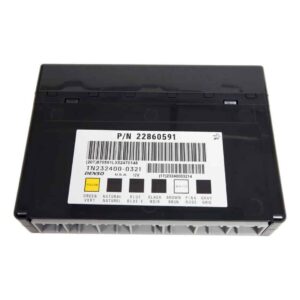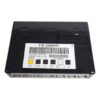Restore Your GM’s Electrical System with a Perfectly Matched BCM
Are you chasing down bizarre electrical gremlins in your 2010 Suburban 1500? Issues like flickering lights, power windows with a mind of their own, a security system that won’t cooperate, or even a frustrating no-start condition can often be traced back to a single component: a failing Body Control Module (BCM). The BCM is the central nervous system for your vehicle’s comfort and security features, and when it fails, it can cause widespread chaos. This isn’t just an inconvenience; it can compromise your vehicle’s safety and reliability.
Instead of facing a costly trip to the dealership for a new module and expensive programming, our professional cloning service provides a direct, effective solution. We transfer the exact data from your original BCM to this replacement unit. This means your vehicle’s specific settings, key fob programming, and security information are perfectly preserved. The result is a true plug-and-play module tailored to your vehicle’s VIN, with the latest GM software updates already installed.
Case Study: A Tricky Diagnosis
A customer brought in a 2010 Tahoe (which uses a similar BCM) with a complaint that was driving him crazy. The radio would turn off randomly, the driver’s side power window wouldn’t work, and occasionally the truck wouldn’t start, showing only a ‘Service Theft Deterrent System’ message. He had already replaced the battery and checked all the fuses. After connecting my scanner, I saw multiple U-codes (communication errors) pointing to the BCM. Instead of a new module requiring a full dealer setup, we performed a cloning service. By transferring his original data, the replacement 2010 Suburban 1500 BCM integrated seamlessly. All the strange electrical issues vanished instantly, and the vehicle was back to normal without any complex key or security relearns.
Common Signs of a Failing BCM
If your vehicle is experiencing these symptoms, a faulty BCM is the likely culprit. Over my 20 years in the bay, these are the most common indicators I’ve seen:
- ✔ Erratic or non-functional power windows, door locks, and interior lights.
- ✔ The security or anti-theft light stays on, preventing the engine from starting.
- ✔ Dashboard warning lights illuminate for no apparent reason.
- ✔ Horn honking unexpectedly or not working at all.
- ✔ Communication error codes (U-codes) stored in the system, such as U0140.
- ✔ Wipers or climate control operating intermittently.
Your Straightforward BCM Swap Guide
Installing your cloned BCM is a manageable job for a confident DIYer. For the 2010 Suburban 1500, the BCM is typically located under the driver’s side of the dashboard, near the steering column.
- Safety First: Always disconnect the negative terminal from your vehicle’s battery and wait 10-15 minutes to allow all systems to power down completely.
- Locate the BCM: Remove the lower dash panel beneath the steering wheel to gain access to the module. It’s a black box with multiple large electrical connectors.
- Swap the Modules: Carefully unplug all wiring harnesses from the old BCM. Unbolt it from its bracket and set it aside. Mount the new, cloned BCM in its place and securely reconnect all wiring harnesses.
- Reconnect Power: Reinstall the dash panel and reconnect the negative battery terminal.
- Perform Relearns: Start the vehicle. As noted in our post-installation procedures, you may need to perform a Brake Pedal Position Relearn or an Airbag System Sync if specific warning lights appear.
Important Post-Installation Steps
Our cloning service handles the heavy lifting, but some systems may require recalibration after the new module is installed:
- Airbag System Sync: If the airbag (SRS) warning light is on, a ‘Setup SDM Primary Key in BCM’ procedure is needed. This requires a professional-grade scan tool to sync the airbag system with the new BCM. This is only necessary if the light is illuminated post-installation.
- Brake Pedal Position Relearn: On some models, the brake pedal position sensor may need to be recalibrated to ensure correct brake light operation and to keep the traction control system happy.
Disclaimer: Procedures can vary slightly by make and model. Always consult a factory service manual or a trusted technician if you are unsure.
Verified Vehicle Compatibility
This BCM is a direct replacement for a wide range of GM vehicles. Please verify your part number and vehicle model from the lists below to ensure a perfect match. This module is compatible with part number 20839063 and interchanges with the following part numbers:
10382479, 15093910, 15276271, 15299986, 15819552, 15828601, 15837419, 15872388, 15872421, 15880684, 15921352, 15921353, 15948438, 15948439, 20815898, 20864767, 20864768, 20921435, 20921436, 20935349, 22860591, 25826124, 25826125, 25847588, 25847589, 25892622, 25910474, 25934762, 25934763, 95151084
Note: Compatibility may depend on specific options or ID numbers. Please match your part number carefully.
Frequently Asked Questions
Frequently Asked Questions
What is a BCM cloning service?
Cloning is a process where we transfer the complete software and vehicle-specific data (like key info, mileage, and options) from your original BCM to the replacement unit. This makes the new module a perfect digital copy, eliminating the need for expensive dealership programming.
Do I need to send my original BCM to you?
Yes. For the cloning service to work, we need your original module to extract its data. After purchase, we will provide instructions on where to send it. We will return your original module with your newly programmed replacement.
Will this fix my ‘Service Theft Deterrent System’ message?
In many cases, yes. A faulty BCM is a very common cause of this warning message and the associated no-start condition. By cloning your original security data, this service is designed to resolve that issue.
Will I have to get my keys reprogrammed?
No. Because we are cloning your original module, all of your existing keys and key fobs will work immediately upon installation, saving you time and money.
Is this a difficult part to replace myself?
For someone with basic mechanical skills, it’s very manageable. The main challenge is accessing the module, which is usually under the dashboard. No special tools are typically needed for the physical swap, but a professional scan tool may be required for post-install relearns if warning lights appear.


